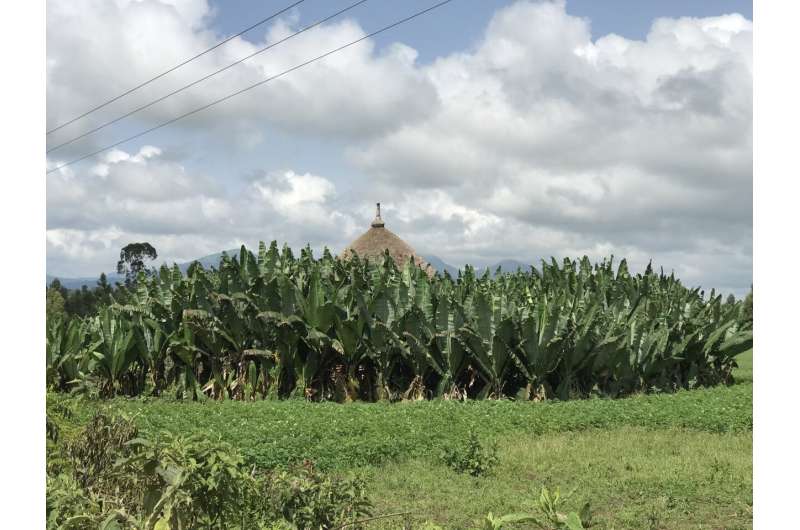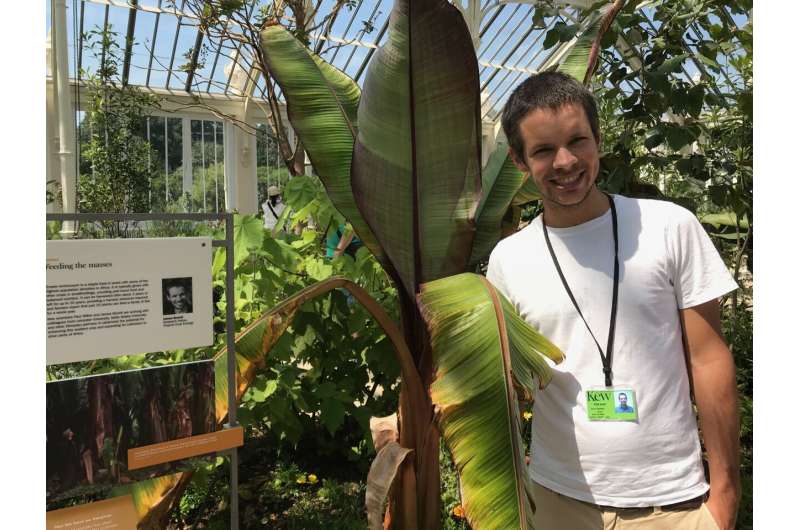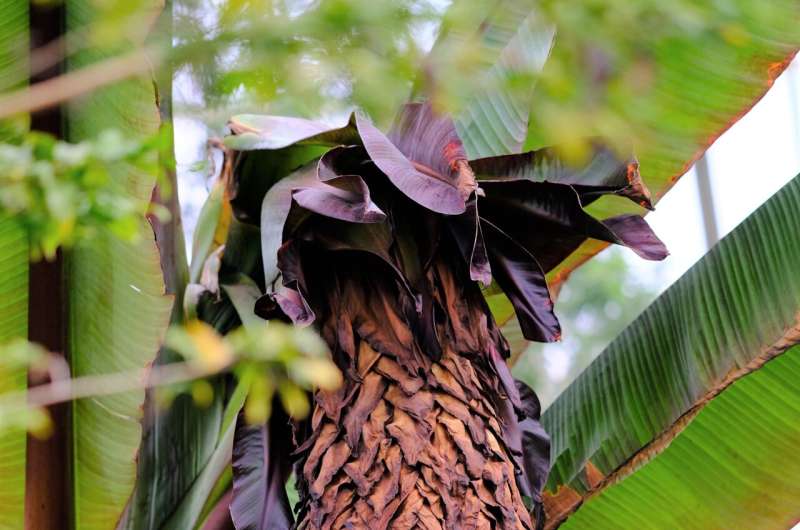This article has been reviewed according to Science X's editorial process and policies. Editors have highlighted the following attributes while ensuring the content's credibility:
fact-checked
trusted source
proofread
Enset, Ethiopia's remarkable 'tree against hunger' flowers at Kew Gardens for the first time

Enset (Ensete ventricosum), an African relative of the much-beloved banana plant, is flowering inside of Kew Gardens' Temperate House, marking the very first time this extraordinary plant has produced an inflorescence at the botanic garden. Royal Botanic Gardens, Kew scientists and horticulturists are now encouraging visitors to hurry up and see the plant in bloom, as due to its monocarpic nature, the plant will flower only once and die.
Known by some as the Ethiopian banana, the Abyssinian banana, or even the false banana, RBG Kew scientists and partners refer to enset as the "tree against hunger." Thanks to its remarkable versatility, drought resistance, and disease tolerance, enset is a staple source of nutrition for more than 20 million people in Ethiopia.
Reaching up to ten meters in height, as few as 15 enset plants can feed a person for an entire year, often propping up diets during periods of drought or when other crops fail. In fact, a recent study published by RBG Kew scientists and partners, has identified enset as a 'climate-coping strategy' in Ethiopia's drought-prone regions.
According to the research, Ethiopian smallholder farmers choose to plant more enset directly in response to drought. Research at RBG Kew has also uncovered the spectacular genetic diversity of enset with the potential to strengthen food security and feed millions more people across the region.
However, despite its hunger-tackling properties, you would not want to eat the plant's impressive, banana-like fruit. They are filled with large, black seeds that make them virtually inedible. Instead, farmers consume the plant's giant pseudostem and underground corm, scraping these parts into a starchy pulp that is fermented in a pit for up to 12 months, before being processed into a bread-like food called kocho.

Dr. James Borrell, Research Leader in Trait Diversity and Function at Kew, says, "Not many people have heard of enset out of Ethiopia and that's a shame because this truly remarkable plant is a vital source of nutrition for millions of subsistence farmers across the region. Enset has a unique set of characteristics that set it apart from other familiar crops; most importantly it's a perennial and can be planted and harvested at any time. As a result, farmers can treat enset as a 'green asset' to buffer against food shortages when other crops fail or are otherwise unavailable, much like a bank account for food. It is no surprise then that Ethiopians frequently refer to enset as the 'tree against hunger.'"
The flowering enset is one of two E. ventricosum specimens that arrived at Kew's nurseries in 2019, measuring just 30cm tall. Prior to their planting in the iconic Temperate House, Kew's horticulturists nurtured the related species E. superbum, which flowered inside the conservatory in 1991.
Previously, Kew's living collections also housed the species E. lecongetti and E. livingstonianum, the latter of which is native from West Tropical Africa to Malawi.

Kew's horticulturists introduced the enset into the South Octagon of the Temperate House in 2020 once it hit a height of 1.5 meters. However, just a year later, the plant was big enough to be moved into a permanent display in the south beds where it has remained since. Today, both enset plants dominate their immediate surrounding with a large canopy of leaves towering over the visitors' head.
As with all monocarpic plants, the enset will die once the flowering period is over. However, a healthy specimen will be selected as its replacement to keep the display going.
David Cooke, Temperate House Supervisor, says, "The enset arrived at Kew in 2019, measuring no more than 30 centimeters in height—pretty much a baby compared to the impressive plant we see in the Temperate House today. Kew's horticulturists took care of it in the lower nurseries before it was mature enough to find a permanent home inside of the historic conservatory. Seeing the enset in flower now is a somber reminder that its time with us is coming to an end but also a testament to the wonderful work our horticulturists and scientists carry out to learn more about the natural world and to protect this planet's biodiversity."
Provided by Royal Botanic Gardens, Kew




















